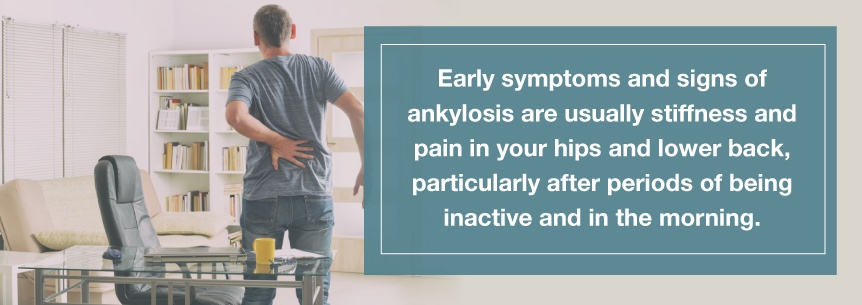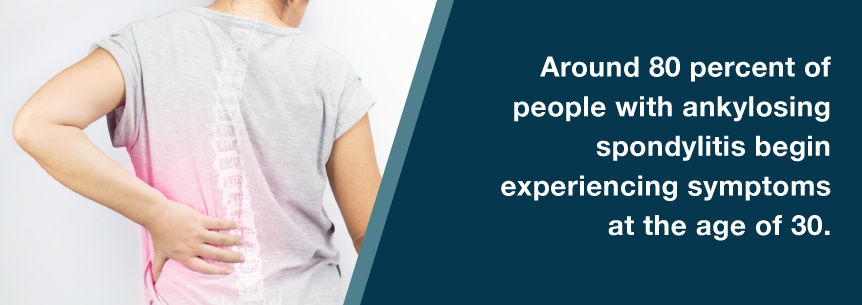For centuries, people have been using cannabis to treat the symptoms of arthritic conditions. Today, researchers are studying the effectiveness of medical marijuana and ankylosis treatment and are seeing good results.
Many of the prescription medications for ankylosing spondylitis and ankylosis patients do more harm than good, and can potentially damage organs like your kidneys and liver. They also come with a long list of negative side effects, such as dizziness, insomnia and addiction. While medical marijuana for ankylosis won’t cure you, it can provide you with a better quality of life without harsh side effects.
Sativex is a cannabis-based drug GW Pharmaceuticals developed in 2005 to treat multiple sclerosis. The drug, however, also shows beneficial effects in treating rheumatoid arthritis, which might make it effective for ankylosis as well. Tests conducted on patients taking Sativex show the drug helps improve the quality of sleep and reduce pain. It’s not psychoactive, and you can obtain it in mouth spray form composed primarily of two cannabinoids found in cannabis naturally — THC and CBD.
Among cannabis’ oldest recorded uses are to relieve chronic pain, inflammation and joint pain. Marijuana has more than 100 different cannabinoids for inflammation, providing it with the capacity for analgesia and numbness through neuromodulation in ascending and descending pain pathways, neuroprotective and anti-inflammatory mechanisms.
Modern scientists are currently studying a network of cannabinoid receptors spread out throughout the body. This new cannabinoid research understanding supports the historical references of marijuana being an effective treatment for inflammation.
Different natural cannabinoids provide various benefits to ankylosis patients. THC works as a pain reliever, and CBD and CBC have essential anti-inflammatory properties. More and more ankylosis patients are choosing medical weed to relieve their symptoms, and they are experiencing excellent results, including improved movement, less pain and reduced need for other medicines.
Best of all, they obtain this symptom relief without the harmful side effects other medications pose.
Find A Doctor Find A Dispensary
Side effects cannabis and ankylosis treatment can help with include:
Medical marijuana is an ideal solution for patients who are suffering from symptoms of ankylosis who cannot find any sense of relief from prescription opiates. Medical marijuana serves as an exceptional medicine for many conditions — however, regarding how it relieves ankylosis, it serves as a muscle relaxer to put the body at ease. Instead of having to complete tedious workouts of isometric exercise and taking opiates to relieve pain, medical marijuana can provide medicinal benefits not found in other treatments.
By also serving as an anti-inflammatory, marijuana can significantly reduce the symptoms of swollen and uncomfortable joints. Patients who are suffering from ankylosis should check to make sure it is within their state’s listed guidelines of approved conditions, and should then contact our service accordingly. Medical marijuana is a compassionate alternative treatment that can greatly benefit your life and your well-being.
Keeping in mind individuals are looking for pain and anti-inflammatory relief, many have found the marijuana for ankylosis strains below to work well.
Similar to there being almost endless cannabis strains, there are also countless ways to ingest medical cannabis for ankylosis for its effects. Some methods include:
Smoking the cannabis plant’s dried flower in a bong, joint or pipe is a common consumption method. Inhaling the herb provides you with fast relief and delivers the cannabinoids into your system with extreme efficiency. However, because smoking weed comes with some of the same negative side effects on your respiratory and circulatory systems as smoking tobacco, it’s not the best delivery method for medical cannabis.
An efficient, smokeless way of inhalation is vaporizing. Vaping heats the plant matter of cannabis, or its oil, to temperatures that force trichomes into the vapors away from the plant.

With edibles, the cannabinoids go through the liver to reach the cells and then converts THC into the more potent 11-hydroxy-THC chemical. You can consume cannabis-infused edibles in numerous forms, including:
Marijuana-enriched salves, lotions, balms and other preparations make up topicals. You absorb the cannabinoids into your skin, which then delivers targeted therapeutic effects.
Tinctures come in various cannabinoid dosages and formulations. You can take tinctures sublingually to deliver the cannabinoids directly into your bloodstream.
Highly potent THC oil named after marijuana advocate Rick Simpson provides healing abilities that treated his cancer.
To begin, you need to learn your state laws regarding marijuana and ankylosis. Once you know what is legal in your state, you’ll then decide what strains you want, what directories to get your cannabis medication from, the proper dosage and other important things.
You’ll also need to find a good cannabis doctor who can help set up your cannabis for ankylosis treatment plan. Dispensary staff will have the knowledge and experience to point you in the right direction for which products you should use to alleviate your symptoms.
The good news is you can take all these steps through one place — MarijuanaDoctors.com. Here, you’ll find a qualified, local cannabis doctor, locate a medical marijuana dispensary and begin your journey toward improving the quality of your life.
Find A Doctor Find A Dispensary
Ankylosis originates from ankylosing spondylitis, which is a condition like arthritis that causes inflammation of your spinal joints, leading to severe, chronic pain and discomfort. More severe cases of ankylosing spondylitis can lead to ankylosis, which involves new bone formation.
When you have ankylosis, your vertebrae fuse, leading to a rigid spine and potentially resulting in a stooped-over posture. Its primary symptoms are stiffness and pain radiating from your neck to your lower back. Getting a diagnosis early and receiving treatment can help manage this stiffness and pain and potentially prevent, or at least reduce, significant deformity.
The back pain you experience with ankylosing spondylitis or ankylosis isn’t the same pain you would experience with other, more common back pain types caused by things like slipped discs or muscle spasms.
The inflammatory pain you have from ankylosis tends to last a long time, turning chronic. But you can reduce the stiffness and pain with treatment. Your doctor will begin your diagnosis by checking for inflammatory back pain signs, such as:
Ankylosis has no cure, but with treatment, you can reduce your symptoms and potentially slow down the disease’s progression.
Researchers haven’t found any specific cause of ankylosis, but they suspect genetic factors are involved. Individuals with the HLA-B27 gene are at a higher risk of developing the condition. However, not all individuals with the gene will develop the disease.
Certain factors can put you at a higher risk for developing ankylosis, including the following.
Ankylosis has a long history, which includes these events:
Early symptoms and signs of ankylosis are usually stiffness and pain in your hips and lower back, particularly after periods of being inactive and in the morning. Commonly, you might also experience fatigue and neck pain.

As the condition progresses, your symptoms could stop at irregular intervals, become worse or even improve.
Commonly affected areas include:
You should see your doctor if you experience buttock or low back pain that came on gradually, wakes you up in the second part of the night when you’re sleeping or worsens in the morning, especially if your discomfort worsens with rest and improves with exercise. If you develop severe light sensitivity, painful red eyes or blurred vision, see an ophthalmologist immediately.
In severe ankylosis, you form new bone as your body attempts to heal. This new bone formation slowly bridges the gap between your vertebrae, and after a while, fuses areas of the spine until they become inflexible and stiff. Fusion could also lead to a stiffened ribcage, restricting your lung function and capacity. And, as mentioned, you could have a stooped-over posture.
Here are some other complications of ankylosis.
Ankylosis can cause substantial impairments in function and decrease your quality of life. Patients have a higher comorbidity prevalence, including psychiatric disorders. Living with ankylosing spondylitis or ankylosis is painful and potentially disabling. As this condition can be chronic, it can also lead to depression.
In fact, the Journal of Rheumatology published research in March 2016 showing individuals with a new ankylosing spondylitis diagnosis are at gan increased risk of depressive disorders compared with individuals who do not have the disease.
The higher rates of anxiety and depression in these patients may be related to the condition itself.
Statistics associated with ankylosing spondylitis, according to Johns Hopkins Medicine, include:

Ankylosis treatment focuses on reducing stiffness and pain, preventing deformities and enabling patients to continue with normal activities. Treatment options include:
Doctors typically recommend NSAIDs as the first-line treatment for ankylosis. NSAIDs help relieve the stiffness and pain symptoms associated with the disease. NSAIDs can either be in the form of over-the-counter drugs like naproxen and ibuprofen or as prescription medications like diclofenac, indomethacin or celecoxib.
Side effects of NSAIDs include:
Your doctor may suggest OTC analgesics like acetaminophen, or they may prescribe you an opioid analgesic like tramadol.
Side effects of analgesics include:
Your doctor may give you a corticosteroid injection into your joints or surrounding tendons to offer you relief. However, these injections will not reduce the spinal stiffness and pain ankylosis causes.
Side effects of corticosteroids include:
These drugs may alter the course of ankylosis. Your doctor may give you a traditional DMARD like sulfasalazine to reduce small joint swelling and pain in your feet or hands if you don’t respond to NSAIDs well. Biologic response modifiers are a subset of DMARDs. Doctors recommend this treatment for people with high disease activity that does not respond well to NSAIDs well. They control the condition at the cellular level.
Side effects of DMARDs include:
Your doctor may recommend joint replacement surgery to help you regain use of your damaged joints. Side effects of surgery include infection and potentially long recovery time.
Researchers are conducting a study to evaluate if computed tomography (CT) scanning measures changes in the fusion or stiffness of the spine better than regular X-rays in ankylosis patients. They also are evaluating if CT can help determine how quickly these patients grow extra bone in their spine.
Researchers and doctors need better techniques for measuring spinal fusion to evaluate how effective medications are at slowing down or stopping its progression. Researchers are also studying the use of a web-based exercise app called Salaso to improve physical activity and increase access to physiotherapy in St James’s Hospital Rheumatology for Ankylosing Spondylitis in Ireland.
Other studies are helping estimate the clinical difference between different doses of Secukinumab and assessing how effective a physical training program would be for patients with the condition.